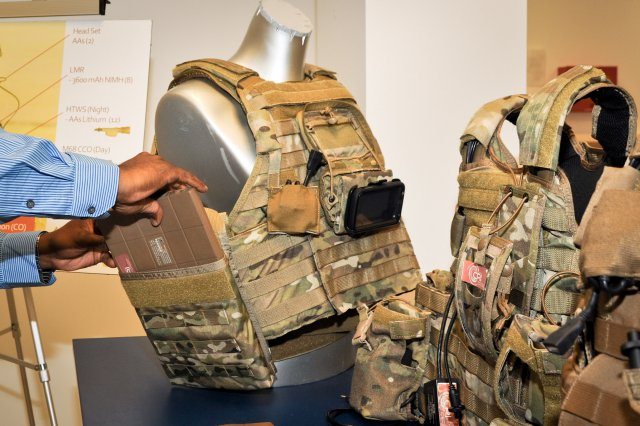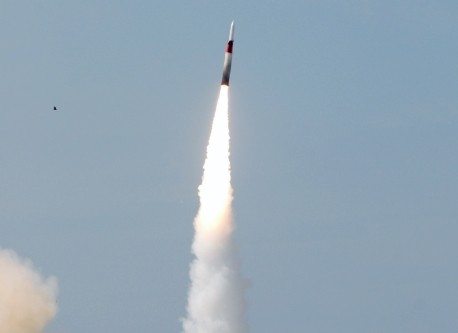The U.S. Army is developing a battery to improve Soldiers’ agility on the battlefield while meeting the demands of an increased power burden stemming from new networked electronic devices.
The Conformal Wearable Battery, or CWB, is flexible and integrates into a Soldier’s body armor. It conforms to the body, which Army officials say is a significant upgrade to traditional batteries that are rectangular and bulky.
The U.S. Army Research, Development and Engineering Command,or RDECOM, and Program Executive Office Soldier have partnered to fulfill the requirements of today’s networked Soldier with the CWB.
ERGONOMIC BATTERY INTEGRATED INTO UNIFORM
Developing a battery that fits seamlessly into a Soldier’s uniform was one of the project’s priorities, said Christopher Hurley, an electronics engineer who leads the battery development projects team at RDECOM’s Communications-Electronics Research, Development, known as CERDEC, and Engineering Center.
“Our role is to develop smaller, lighter, cost-effective power sources,” Hurley said. “Providing a wearable, ergonomic, comfortable footprint is key. [We took] that big, bulky battery and made it conformable and more comfortable to be worn by the Soldier.”
The CWB provides more power, reduces the need for battery re-charging and spares, and serves as a single source of power for all worn electronic devices, Hurley said.
Hurley said the Army’s standard batteries, the BA-2590 and BA-5590, were designed to be placed in battery boxes and large communication equipment and not to be worn by the Soldier to power his electronics.
The CWB, however, is made specifically to be worn within a tactical vest, said Steve Mapes, product director for Soldier Power within PEO Soldier’s Project Manager Soldier Warrior.
“[The conformal battery] allows the Warfighter to share space with other equipment that he has to carry on his load carriage,” Mapes said. “A traditional 2590 or 5590 does not share space on the body armor. It requires its own committed space on the load carriage.
“When you slip a conformal battery into the protective vest and over the [Small Arms Protective Insert] plate, it’s virtually invisible and transparent to the Soldier. Now the Soldier can still hang his magazine, grenades or flashlight over the battery. The conformal battery allows the Soldier to share valuable, limited real estate.”
SINGLE SOURCE OF POWER
Hurley and his fellow CERDEC engineers have developed six CWB prototypes since 2008. During each iteration, the goal has been to demonstrate a battery that is smaller, lighter, provides longer-lasting power and eliminates the need for a separate battery for each electronic device, he said.
“We look to reduce a Soldier’s load with the number of batteries [Soldiers] carry and consolidate that into as few batteries as we can,” Hurley explained. “The conformal battery is a centralized power source for all the things that a Soldier needs to carry — GPS, smartphone, radio, other electronics, (and) eliminate the extra batteries for each individual item.”
“No longer do you need to carry extra radio or GPS batteries,” he continued. “You only need to carry spares for the conformal battery.”
CERDEC accomplishes these advancements through experimenting in the laboratory with different chemistry formulations that yield a high-energy, high-power battery that is safe, Hurley said. The target is a battery that enables 72 hours of continuous operation.
MEETING NETWORKED SOLDIERS’ POWER REQUIREMENTS
The Army’s conventional batteries can no longer handle the power demands for worn devices such as Nett Warrior, a handheld tool that provides situational awareness and mission command capabilities, Mapes said.
These networked systems are always sending and receiving data, similar to leaving a cell phone on during a flight. They continuously search for a signal, which rapidly drains the battery.
“The introduction of ‘Soldier in the network’ brings with it an unprecedented level of capability and amount of power consumers that are worn on the individual warfighter,” Mapes said. “You have a power burden that has never before been imposed upon Soldiers, particularly the small-unit leaders. The traditional power strategy for the individual warfighter was fast becoming impractical and irrelevant.”
SUPPORT THROUGH DEFENSE ACQUISITION CHALLENGE
Mapes said the Defense Acquisition Challenge Program,or DAC, helped the Army accelerate the battery’s progress and ultimately deliver them to Soldiers sooner. DAC provided a portion of the project’s funding from 2010 to 2012.
“DAC allowed us to take samples earlier for testing and validation,” Mapes said. “[We received] preliminary Soldier feedback so we could make some immediate improvements on the battery and get a more production-representative version out to the formations. We leveraged everything we could to accelerate tests, user feedback, exposure of the battery to the formation.”
“Bottom line, we wouldn’t have had the batteries available to go through these tests and get the Soldiers to use and evaluate them had it not been for these earlier efforts,” Mapes continued.
The Department of Defense established DAC in 2003 in response to a Congressional mandate for a program that was innovative, flexible, competitive and affordable to integrate mature technologies into the acquisition cycle.
The Office of the Secretary of Defense Comparative Technology Office evaluates the proposals and selects candidates for funding. The RDECOM Global Technology Integration Team manages the program for the Army. DAC was funded through fiscal year 2012.
BENEFITS OF ARMY R&D CENTER
Hurley emphasized that working with an Army research, development and engineering center includes complete program management — development, prototyping, engineering support, in-house testing and evaluation.
“Not only do we have the expertise of developing batteries and other power sources, but we also understand how these come together in a Soldier network for something like Nett Warrior,” Hurley said. “We understand the integration and how the battery marries up with the other Soldier-borne electronics.
“Our lab is different because we develop complete products. We do not develop a single component. We are a product-oriented organization.”
FUTURE OF CONFORMAL BATTERY
PEO Soldier and CERDEC have taken the CWB to large Army demonstrations and exercises such as the C4ISR Network Modernization, Army Expeditionary Warrior Experiment and Network Integration Evaluation. These tests allow the organizations to capture Soldiers’ feedback that will shape future versions of the battery.
Mapes said the battery will make a significant improvement in Soldiers’ missions.
“We have already realized gains in the area of Soldier load and reduction in the numbers and types of battery. I’m very encouraged by the feedback. I don’t have to sell it. I find myself in the pleasant position of not having to convince Soldiers that they need this. They’re requesting it. It’s very gratifying,” he said.
RDECOM is a major subordinate command of the U.S. Army Materiel Command. AMC is the Army’s premier provider of materiel readiness — technology, acquisition support, materiel development, logistics power projection, and sustainment — to the total force, across the spectrum of joint military operations. If a Soldier shoots it, drives it, flies it, wears it, eats it or communicates with it, AMC delivers it.











